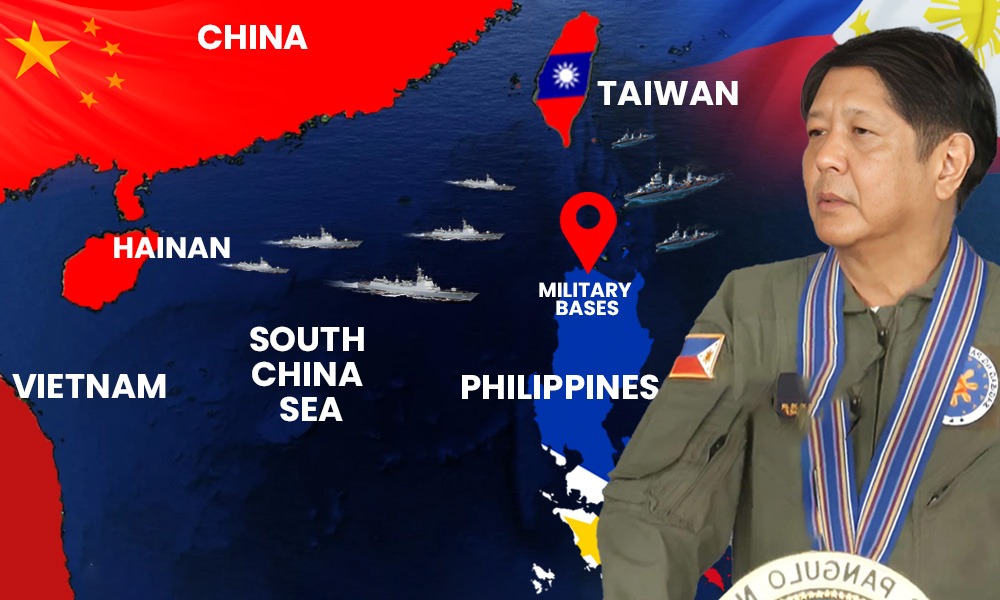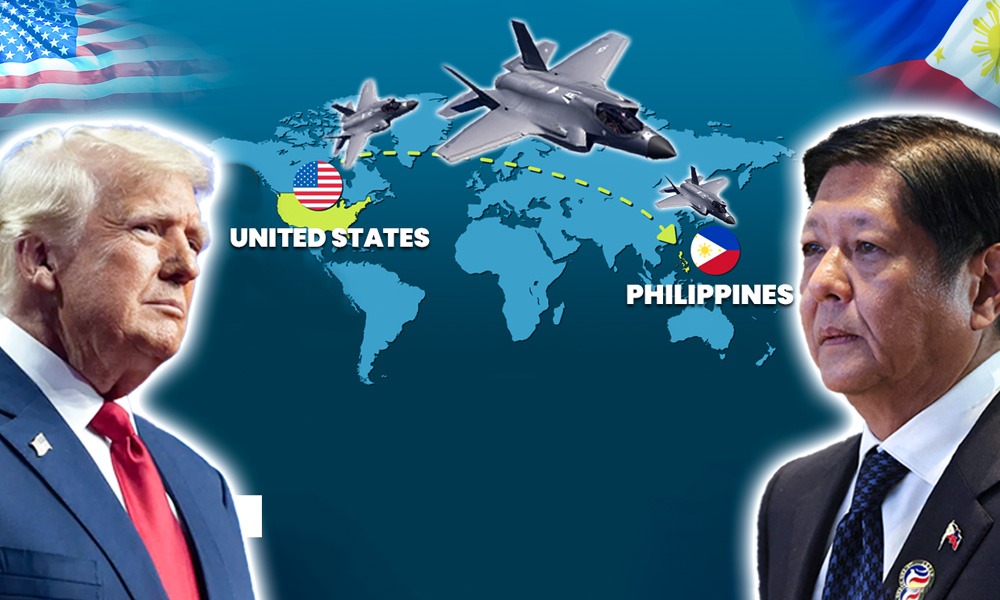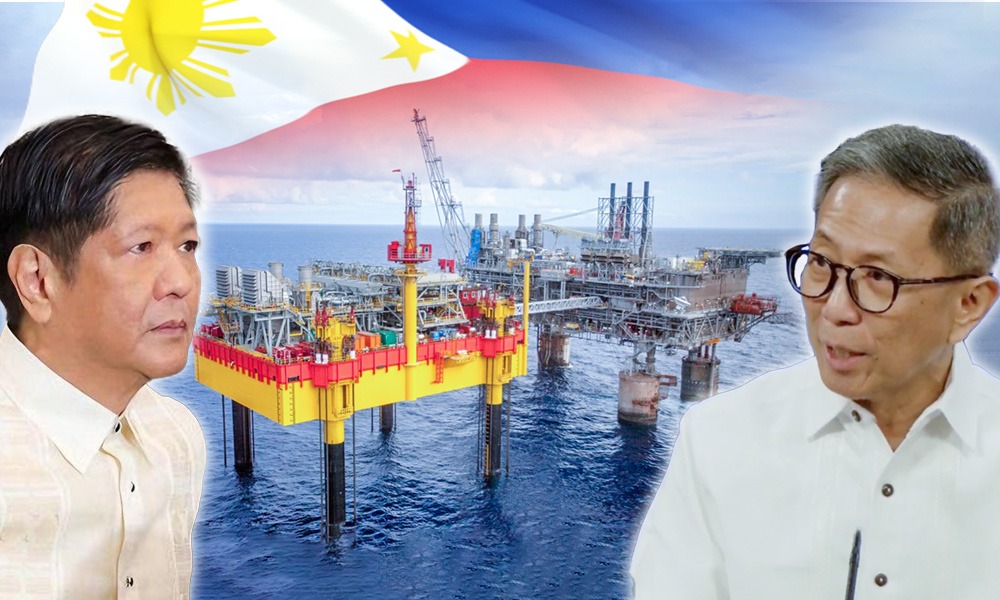The external threat now has become more pronounced, more worrisome.” President Ferdinand Marcos Jr., February 2025
Something’s changing in the Pacific and fast. Not long ago, the Philippines was focused inward. Its soldiers chased insurgents in the jungles of Mindanao. Coast guards cracked down on pirates and smugglers in the southern seas. Disaster relief was the main mission. The north? Quiet. Peaceful. Almost forgotten.
But not anymore.
Now ask yourself this, why is the Philippines suddenly building military bases just 200 kilometers from Taiwan? Why are tiny, windswept islands like Itbayat and Mavulis suddenly in the headlines?
The answer lies in one narrow strip of ocean: the Luzon Strait. It may look like just open sea, but this waterway is one of the most strategically explosive corridors on Earth. It connects the contested South China Sea to the wider Pacific. It’s where Chinese submarines hide, U.S. warships pass, and global trade flows. If conflict ever erupts over Taiwan, this is where the sparks will fly first.
And who sits right at the chokepoint? The Philippines.
For years, Manila tried to stay out of great-power politics. It balanced ties with China and the U.S., kept its distance from Taiwan tensions, and hoped diplomacy would hold. But those hopes are fading fast. After Chinese missile tests in 2022 sent warheads flying near Japan, and Chinese warships began lurking near Philippine shores, something snapped.
The Philippines is no longer watching from the sidelines. It’s joining the game and raising the stakes.
Today, U.S. troops are back on Philippine soil. New EDCA sites are popping up in Cagayan, Isabela, and Batanes, all facing Taiwan. Joint drills like Balikatan now simulate Taiwan evacuation scenarios. Coast guard stations in the north double as emergency supply hubs, and, quietly, military staging grounds.
This isn’t just about Taiwan. It’s about protecting 150,000 Filipinos working there. It’s about safeguarding trade routes, sovereignty, and survival. The Philippines now sees what’s at risk, and it’s not waiting for the storm to hit.
Behind the headlines, a transformation is happening. A defensive nation is becoming a strategic actor. A quiet player is taking center stage. The Philippines is positioning itself not just as a buffer state, but as a frontline power in the First Island Chain, the last line of defense between peace and Pacific conflict. This is a high-stakes balancing act: economic ties with China vs. security with the U.S., a “One China” policy vs. quiet coordination with Taiwan. But Manila knows the cost of inaction. In today’s Indo-Pacific, neutrality is not an option.
And so the Philippines moves forward, building bases, training troops, fortifying islands, and writing its place in a new chapter of Asian geopolitics. Because what happens in Taiwan won’t stay in Taiwan. And in this unfolding story, the Philippines is no longer a bystander. It’s part of the plot.
Core Motivations and Factors
The Philippines is quietly reshaping its defense strategy and the world is starting to notice. With tensions over Taiwan reaching boiling point, Manila is no longer just watching from the sidelines. It’s building military outposts just a few hundred kilometers from Taiwan, expanding its alliance with the United States, and preparing for what many fear could be the next major conflict in Asia.
It all starts with geography. The Luzon Strait, the narrow stretch of water between Taiwan and the Philippines has become one of the most strategically sensitive zones in the Indo-Pacific. When then-U.S. House Speaker Nancy Pelosi visited Taiwan in 2022, China launched a massive show of force. But those war games didn’t stop at Taiwan’s shores, Chinese warships and aircraft were spotted in the Luzon Strait, deep inside the Philippines’ strategic backyard. That moment was a wake-up call. If war breaks out over Taiwan, the Philippines will be on the frontlines.
And there’s more than just military spillover to worry about. Over 150,000 Overseas Filipino Workers live in Taiwan, each one representing a family back home, and a potential humanitarian crisis in the making. In the words of a Philippine official in 2022, “We cannot be neutral if our people are caught in the middle.”
At the same time, the Luzon Strait has become a hotspot for foreign vessels, particularly Chinese survey ships. These are not harmless scientific missions. They’re mapping the seabed, monitoring maritime traffic, and testing the boundaries of Philippine sovereignty. National Security Adviser Eduardo Año put it bluntly in 2024: “Securing peace, stability and freedom of navigation along the Luzon Strait is non-negotiable.” That’s why Manila established a new Coast Guard station on the remote island of Itbayat, right on China’s radar.
This rising tension has turbocharged Manila’s military ties with Washington. Under President Marcos Jr., the Enhanced Defense Cooperation Agreement or EDCA has roared back to life. What used to be a low-key partnership is now a high-stakes alliance. In the past year alone, the Philippines has nearly doubled the number of its military bases accessible to U.S. forces, from five to nine. And three of those new bases are located in northern Luzon, chosen precisely because they’re close to Taiwan.
Take Naval Base Camilo Osias and Lal-lo Airport in Cagayan, they’re both less than 400 kilometers from the Bashi Channel, a key passageway between Taiwan and the Philippines often used by submarines and warships. Camp Melchor Dela Cruz in Isabela adds even more strategic depth. These aren’t just dots on a map, they’re launchpads for joint military action, should a Taiwan crisis erupt.
That’s exactly what the annual Balikatan military exercises are now preparing for. In April and May 2024, over 16,000 U.S. and Filipino troops trained together, not just in general drills, but in simulated Taiwan contingency operations. The new EDCA sites were used, and scenarios included air defense, logistics, and rapid deployment. President Marcos may insist that these bases are not for offensive use, but even he admitted: “They will prove to be useful for us should that terrible occurrence come about” meaning a Chinese invasion of Taiwan.
But there’s another layer to all this: disaster preparedness. The Philippines faces around 20 typhoons a year, plus regular earthquakes and volcanic eruptions. That’s why many of these new military facilities are labeled as “dual-use” capable of storing humanitarian supplies, but equally able to hold military gear. The U.S.-Philippine facility on Itbayat, for example, is described as a “weatherproof warehouse” but it’s also built to support airlifts and evacuations, especially if thousands of OFWs need to be rescued from Taiwan.
In fact, recent joint drills included a scenario for mass evacuation of Filipino migrant workers. This isn’t just military coordination, it’s life-saving preparation. According to China US Focus (Jan 2025), humanitarian response has become a central justification for increased U.S. presence in the north, giving the Marcos administration political cover while reinforcing national defense.
All of this takes place within the broader chessboard of Indo-Pacific geopolitics. Taiwan sits at the heart of the so-called “First Island Chain” , a natural wall of allied territory that prevents China’s navy from projecting power freely into the Pacific. The Philippines is a critical link in that chain. If Taiwan falls, analysts say, the entire regional balance could collapse. A report by SLDinfo.com (June 2025) warned, “The loss of this central link [Taiwan] would fundamentally reshape regional security dynamics.” Worse, China would effectively bracket the Philippines between the South China Sea and the Philippine Sea, turning it into a maritime sandwich between two Chinese-dominated zones.
In that nightmare scenario, Manila loses control not just of its waters, but of its trade, its economy, and its future. That’s why the stakes are so high. The moves being made today, from building coast guard stations on remote islands to opening up bases to U.S. troops, aren’t just about today’s news cycle. They’re about preparing for tomorrow’s crisis.
The Philippines may not be the biggest military power in the region, but its location makes it one of the most important. And right now, it’s quietly fortifying itself for a conflict it hopes never comes, but knows it might.
Locations and Types of Facilities
If war breaks out in the Taiwan Strait, these small, windswept islands in the Philippines might be where it all begins.
Let’s start in Batanes, the country’s northernmost province and its closest point to Taiwan. Just 190 kilometers away sits Itbayat Island, once known for its remoteness and rugged beauty. Today? It’s rapidly turning into a military and humanitarian outpost. In 2024, the Philippine Coast Guard opened a brand-new station there, and just beside it, a joint US-Philippine facility has been quietly constructed, officially stocked with emergency supplies, but analysts say it could easily double as a logistics hub in wartime. According to RAND (Feb 2025), this “dual-use” model offers both disaster readiness and rapid deployment potential.
But the real frontline might be even closer.
Travel further north, and you’ll reach Mavulis Island, also known as Y’Ami, just 143 kilometers from Taiwan. It’s the tip of the spear, literally. What started as a fishermen’s shelter has quietly evolved into a tiny naval outpost. Philippine military personnel are now stationed here year-round, complete with a helipad, radar, and surveillance facilities. Back in 2019, few paid attention when Al Jazeera reported the island’s militarization, but in 2025, it’s hard to ignore. As Philippine Defense Secretary Gilberto Teodoro warned in February, “Batanes is the spearhead of the Philippines as far as the northern baseline is concerned, and it will be defended as such.”
Zoom out, and the map gets even more serious.
$5.6 Billion F-16 Deal: Why the Philippines’ Air Force Is Now Really a Regional Game-Changer?
In Northern Luzon, just south of Batanes, lie the most strategically critical military assets under the Enhanced Defense Cooperation Agreement (EDCA). Here, three key sites now grant U.S. troops access and they’ve all been chosen with Taiwan in mind.
First is Naval Base Camilo Osias in Santa Ana, Cagayan. Facing the Taiwan Strait directly, this base puts the U.S. Navy within easy striking distance of any unfolding conflict. Next, just inland, is Lal-lo Airport, a commercial facility that’s been rapidly adapted for military use. During the massive Balikatan exercises in 2024, it was used to launch simulated air assault missions across the Luzon Strait into the northern islands—exactly the kind of maneuver that would be needed in a real Taiwan crisis. Finally, there’s Camp Melchor Dela Cruz in Isabela, a seasoned military facility now upgraded to host U.S. forces under EDCA. All three bases are positioned within 400 kilometers of the Bashi Channel—one of the most critical maritime chokepoints in the world.
Why does that matter?
Because in a Taiwan conflict, the Bashi Channel will either be the bridge through which the U.S. and allies send reinforcements, or the chokehold through which China tries to cut Taiwan off from the world. According to FPRI (June 2023), “Control of the Bashi Channel could make or break any cross-Strait military campaign.”
That’s why the Philippines is acting now, not later.
These facilities might look like simple outposts or upgraded airports, but in reality, they are chess pieces in a far larger geopolitical game. A game where timing, location, and access mean everything. And while the world watches Taiwan, it’s the quiet moves on remote islands like Itbayat, Mavulis, and in Northern Luzon that could ultimately decide who controls the future of the Pacific.
Regional Reactions and Implications
As U.S. troops arrive in Northern Luzon and new military bases rise in the shadow of Taiwan, Beijing is fuming. China sees this not as routine defense but as an aggressive chess move aimed right at its doorstep.
In Beijing’s eyes, the Enhanced Defense Cooperation Agreement (EDCA) isn’t just a bilateral pact, it’s part of a U.S.-led strategy to “encircle and contain China.” Chinese state media now accuses Washington of “stoking the fire” of regional instability. And every new military drill, every new facility near Taiwan’s front yard, only fuels that narrative. In fact, when then-House Speaker Nancy Pelosi visited Taiwan in 2022, China launched ballistic missiles that landed inside Japan’s Exclusive Economic Zone, a not-so-subtle warning to U.S. allies closest to Taiwan, including the Philippines.
Yet just across the Strait, Taiwan sees a completely different picture.
Far from alarmed, Taiwanese officials are openly welcoming closer security ties with the Philippines. In a rare and direct message, Taiwan’s Foreign Minister Joseph Wu said, “As long as there’s a desire on the part of the Philippines, Taiwan will be there to work together… especially in coast guard cooperation.” That kind of alignment is unprecedented and signals a quiet but growing security handshake between Manila and Taipei.
But here’s the diplomatic tightrope: the Philippines officially supports the One China Policy. It doesn’t recognize Taiwan as a sovereign state, at least on paper. And yet, behind the scenes, the two are economic and cultural partners. In 2021 alone, Taiwan ranked as the 9th largest trade partner of the Philippines, with $2.5 billion in bilateral trade. And those unofficial ties are growing, especially in areas like tech, shipping, and labor.
So how does Manila navigate this high-stakes balancing act?
It’s tricky. On one hand, it’s deepening defense ties with the U.S. and quietly aligning with Taiwan on key security issues. On the other, it must manage its political and economic relationship with Beijing, which remains a powerful trade partner and unpredictable actor in the South China Sea.
Zoom out, and the picture becomes even more complex.
The Philippines isn’t moving in isolation. It’s part of a broader U.S. strategy across the Indo-Pacific, spreading out forces across multiple islands and allies to make any potential Chinese invasion or retaliation far more difficult. From Japan’s southern islands to Palau and the Philippines, this strategy creates a dispersed, hardened network meant to deter aggression without firing a shot.
But as new bases rise, drills intensify, and alliances evolve, the region inches closer to a tipping point. Whether it’s diplomacy, deterrence, or confrontation, everyone from Taipei to Tokyo to Manila now knows: if Taiwan goes hot, the entire region will feel the burn.
Conclusion
The Philippines is no longer sitting on the sidelines. A quiet but dramatic shift is underway, a new era of Philippine defense strategy that’s more assertive, more forward-leaning, and undeniably more consequential. For decades, Manila’s military focus was largely inward, counterinsurgency, disaster response, border patrol. But now, with Chinese warships shadowing the Luzon Strait and tensions over Taiwan rising fast, the Philippines is turning its gaze outward. It’s not just defending territory anymore, it’s defending its position in a rapidly evolving Indo-Pacific.
The message is clear: what happens in Taiwan won’t stay in Taiwan. The destinies of the Philippines and the Taiwan Strait are increasingly intertwined, linked by geography, trade, and strategic vulnerability. That’s why Philippine bases are being reinforced in Batanes and Cagayan. That’s why U.S. troops are rotating through the archipelago. That’s why exercises like Balikatan are preparing not just for typhoons, but for missile strikes, evacuations, and war contingencies.
And this isn’t a temporary pivot. The development of northern defense hubs, the enhanced interoperability with U.S. forces, and the quiet but real coordination with Taiwan, all point toward a long-term realignment. The Philippines is stepping up, not just as a frontline state, but as a key player in the region’s security architecture.
Yes, this comes with risks, geopolitical friction, economic backlash, diplomatic balancing acts. But Manila seems ready. As the Indo-Pacific heats up, the Philippines is no longer just reacting, it’s positioning. In this new strategic reality, neutrality is not an option. Whether by choice or necessity, the Philippines is writing itself into the front lines of history.



